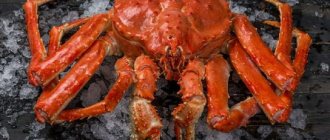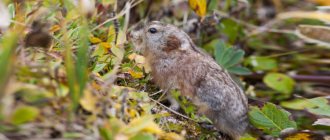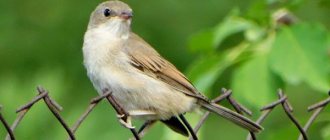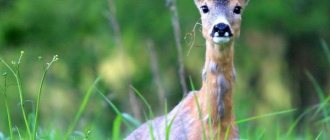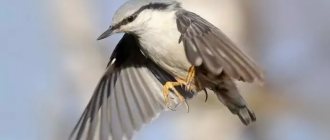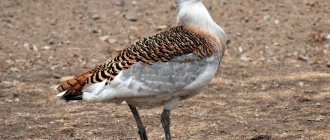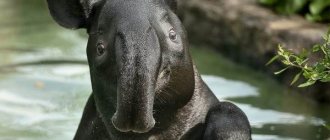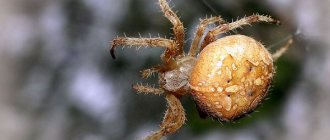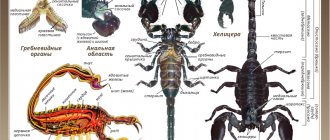- Wild animals
- >>
- Mammals
Grizzly bear , which translated from English means “gray” bear, is one of the most dangerous and largest predators inhabiting our planet today. They migrated to the forests of North America from Asia more than a hundred thousand years ago. According to most scientists, the grizzly bear does not belong to an independent species, but is a type of common brown bear.
Origin of the species and description
Photo: Grizzly Bear
It's hard to believe that the huge and strong grizzly bear, like its white and brown brothers, as well as raccoons and foxes, descended from a common ancestor more than 30 million years ago. This animal lived on the territory of modern Eurasia, was not distinguished by its impressive size and deftly jumped through the trees.
Among those individuals that eventually moved to North America, scientists previously identified about eighty species of grizzly bears. As science developed and modern genetic tests were carried out, it turned out that the grizzly bear is nothing more than a subspecies of the European brown bear. Today, the continental and coastal forms of these dangerous predators are distinguished, uniting them under one common official formulation - the brown bear.
At the beginning of the last century, the total number of grizzly bears was more than one hundred thousand individuals.
However, as people populated their habitat, cases of attacks by these predators on farmland, livestock, and even humans themselves were increasingly observed. Its excessive aggressiveness caused mass shooting and, as a result, a sharp reduction in the number of these animals - almost 30 times. Today, the North American grizzly bear is listed in the International Red Book and lives in strictly protected protected areas. The grizzly bear is one of the ten most dangerous and aggressive predators on the planet.
Kermode (weight up to 300 kg)
The Kermode bear is named after the scientist Francis Kermode, who was the first to describe this animal. The Kermode bear is white or cream in color. But he is not a relative of the northern polar bear, but, on the contrary, a subspecies of the American black bear - baribal. Its body size is 1 m 80 cm, weight is about 300 kg.
The kermond lives in Canadian hard-to-reach forests. The Indians consider him a “ghost bear”; he is cautious and timid, and does not attack people. The mysterious animal loves to hunt salmon during spawning; collects mushrooms, berries, roots, fruits; will not refuse honey and carrion.
Appearance and features
Photo: What a grizzly bear looks like
The name “Grizzly” for these powerful predators is absolutely not accidental. Thus, for the specific gray color of their coat, they were nicknamed by ancient settlers who first saw this bear in the North American forests. With the exception of the smoky color of the coat, the grizzly bear is very similar in appearance to the Russian brown bear.
This is a large predator whose size is amazing:
- The weight of an adult can reach 1000 kg;
- Height at withers – up to 2 m;
- The total body length is up to 4 m.
Females usually look much smaller than males. The grizzly bear is incredibly strong; with one blow of its mighty paw it is capable of breaking the victim's spine, leaving him no chance of salvation.
A distinctive feature of “gray” bears is their curved and extremely sharp 15-centimeter claws. Thanks to them, the grizzly bear is rightfully considered an excellent and dexterous hunter, but is completely incapable of climbing trees. These predators have well-developed muscles, a strong body covered with thick and coarse hair. Upon closer inspection, the color of a grizzly bear is still brown, and only from a distance does it acquire an unusual gray tint.
Unlike their Eurasian counterparts, North American bears have a low-set skull, a wide forehead, a protruding nose and small round ears. In addition, the tail of a grizzly bear is much shorter and almost invisible compared to a brown bear. Like all representatives of their species, these powerful predators waddle awkwardly when walking, dynamically swinging the body of their body.
Where does the grizzly bear live?
Photo: Grizzly bear standing
In most cases, grizzly bears are characterized by harsh habitats that are difficult for humans to reach. Initially, the range of these predators included the Great Plains and a large part of the southwestern United States. Over time, developing civilization pushed the grizzlies far to the north and high into the mountains. Today, the bulk of the gray bear population lives in northern Canada and Alaska. However, representatives of this rare species can sometimes be found in the states of Idaho, Wyoming, Montana and Washington.
For a comfortable proximity to humans and to preserve the number of grizzly bears, the US authorities have created special protected National Parks, where each individual is carefully monitored using the latest scientific and technical developments. Compared to the 20th century, today the population of this type of predator has increased significantly and numbers more than 50,000 animals. This sudden increase is curbed by sanctioned seasonal hunting.
Grizzlies prefer to live in dense forests, where they can enjoy plenty of plant fruits, berries or nuts. However, if there is a lake or river nearby, this animal will not miss the opportunity to prove itself as a skilled fisherman. In coastal areas, predators that usually prefer to live alone gather in groups for more productive and successful fishing.
What does a grizzly bear eat?
Photo: Animal grizzly bear
Due to repeated attacks on people and livestock, the grizzly bear has a reputation as a cruel and merciless killer. However, this is not entirely true, and this type of predator objectively belongs to the category of omnivores. In ordinary life, when his aggressive behavior is not provoked by anything, the bear gives preference to plant foods: berries, roots, shoots and fruits of plants. In addition, these powerful animals happily feast on bird eggs, reptiles and their future offspring, frogs and insects.
They also do not neglect carrion, the smell of which they can smell at a distance of several tens of kilometers.
For the coastal variety of grizzly bears, fish is a significant part of the daily diet. When the time comes for spawning, and the prey itself jumps out of the water, the tenacious paws of the predator with dexterity pick it up right on the fly.
As for large animals, most likely the grizzly will choose as prey an old and sick individual sika deer, ram, goat, or chamois, as well as inexperienced young animals of other forest inhabitants. According to popular belief, bears are great connoisseurs of honey. This is true, only this delicacy is available mostly to bear cubs, due to their small size and ability to climb trees.
The teeth of a gray bear have a specific shape and are intended for various types of food - both plant and animal. An adult needs to consume about 20 thousand kilocalories per day. Such an urgent need for food forces grizzlies to almost constantly be in a state of search for food, especially before hibernation.
Nutrition
Despite their reputation as an aggressive predator, grizzly bears are omnivores and prefer plant foods. The animal's favorite delicacies are wild berries, nuts and sweet roots. Plants make up up to ¾ of a grizzly's diet; in a hungry year, animals safely raid fields with grains and legumes, eating up a colossal portion of the harvest.
The protein diet consists of eggs of birds and reptiles; grizzlies are not averse to eating newly hatched chicks and reptiles. The clubfoot does not disdain insects: it can eat up to 40,000 butterflies or moths per day.
The grizzly bear has a sense of smell a hundred times more sensitive than that of humans.
Small animals also become prey for the grizzly: marmots, lemmings or voles constitute its food interest. Large prey - moose or wild bulls - are found much less frequently; in coastal areas, bears catch sea lions and seals.
Bears cannot be called scavengers in the full sense of the word, but they are not averse to eating the meat of dead animals and can smell them from several tens of kilometers away; if you are lucky, you can even find the carcass of a whale washed up on the shore.
You can also meet a bear in landfills where there is food waste; this applies not only to garbage left by tourists, but also to bins near human settlements. Mostly waste becomes the prey of sick and old individuals, but even the weakest animal will not finish eating other animals, be they bears or predators of other species.
If a river flows not far from the grizzly bear’s habitat, the animals get themselves fish, their favorite varieties being salmon and trout, and the bear is able to catch them on the fly with his teeth or claws and immediately swallow them. If several bears have settled in one place at once, they divide the fishing zones among themselves and do not violate the boundaries.
For the sake of honey, bears uproot mature trees on which the hives are located, then destroy the bees’ homes and extract the sweet delicacy. Due to their light weight and physical strength, grizzly bear cubs
To replenish fat reserves for the winter, an adult male needs to consume up to 20,000 calories daily. The phenomenon of an increased sense of hunger in order to accumulate fat, which will warm in the cold, is called polygraphy in bears.
Features of character and lifestyle
Photo: Angry grizzly bear
The main distinguishing character trait of a grizzly bear is its aggressiveness and fearlessness. These qualities, combined with its incredible strength, make this predator extremely dangerous. The gray bear, despite its external massiveness and apparent clumsiness, moves very smoothly and almost silently, which allows it to get as close as possible to a potential victim, leaving it no chance of salvation.
The vision of grizzlies, like other bears, is rather weak. But they are well oriented in space with the help of very subtle hearing and smell. Grizzly bears are great runners! It easily reaches speeds of up to 60 km/h, and can be compared in agility with a racing horse. In addition, this powerful predator is an excellent swimmer, willingly bathes in the hot season, and it will not be difficult for him to ford a small river.
When faced with a dangerous opponent, a grizzly bear stands on its hind legs and emits a terrifying roar, thus demonstrating its physical superiority and readiness to attack. This animal is absolutely not afraid of humans, but this does not mean that it will definitely attack. Most often, people are attacked by bears that are wounded, too hungry, or provoked into retaliatory aggression.
The grizzly is a sedentary and solitary animal. Having reached adulthood, they rarely leave their hunting area, the boundaries of which are carefully marked and protected. Forest grizzlies strip bark from border trees with their sharp claws, and those who live in the mountains can mark stones, cliffs, or even tourist tents in this way.
The grizzly bear becomes most active at dusk and early in the morning. During the day, this predator prefers to rest, enjoying a hearty lunch. It is worth noting that his interest in food depends very much on the time of year. Before hibernation, a grizzly bear must gain up to 200 kg of body weight to survive the winter. This need forces him to constantly search for food.
In different climatic zones, the gray bear goes into hibernation in October or November and wakes up in early spring - in March or April. In winter, females with newborn cubs sleep much longer than young males, and older individuals wake up first.
Social structure and reproduction
Photo: Grizzly Bear
For most of its life, the grizzly bear prefers solitude and keeps to itself. However, his usual isolation disappears with the onset of the mating season. After a long winter sleep, from the end of spring until the onset of summer, male grizzlies go in search of females in order to procreate.
Thanks to the specific smell and special marks on plants, sexually mature individuals find their chosen ones who are ready to mate. However, the idyll does not last long - after 2-3 days the lovers part forever. If fertilization is successful, two or three small bear cubs will be born in the middle of winter in a warm den.
Newborn grizzlies bear little resemblance to bears - they are completely blind, devoid of fur and teeth, and weigh no more than a kilogram. But, after six months of maternal care and nutritious breastfeeding, the future predators noticeably grow stronger and at the end of spring they leave the den with a rather confident gait. Little grizzly bear cubs are very active and have a cheerful and playful disposition. They are easily tamed, and once in human hands, they turn into obedient pets. In some cases, they acquire the ability to protect their owner from danger.
Before the coming winter, a mother bear with her already grown cubs is looking for a more spacious den. After two years from the moment of birth, young grizzlies leave their mother forever and go into an independent solitary existence. The average lifespan of a gray bear is about 30 years, but in captivity and with proper care this animal can live much longer.
Baribal (weight 330 – 360 kg)
Kermond's relative, the baribal, is in the middle of the ranking of the largest bears in the world. This two-meter-tall animal with black sparkling fur lives in the wooded areas of Canada, the United States of America, and Mexico. The food for this bear is fish, larvae, insects, acorns, and fruits. Sometimes attacks livestock.
The weight of the largest male is 363 kg. Its lifespan ranges from ten years in freedom to thirty in captivity. Now there are about 600 thousand baribals.
Natural enemies of the grizzly bear
Photo: What a grizzly bear looks like
It is difficult to imagine that such formidable predators as grizzlies could have enemies in the animal kingdom. Indeed, few people will dare to fight a mighty bear, unless it is an equally formidable beast, equal to it in strength and fearlessness. Nature is designed in such a way that those predators that could be a real competitor to the grizzly bear, such as a tiger or a lion, do not live in the same territory with it, thereby leaving it as the rightful owner of its lands.
However, if we consider in general the possibility of causing any harm, then the following “enemies” can be identified for the gray bear:
- Other bears - especially during the mating season, these predators become extremely aggressive. Males can engage in mortal combat for the female they like, or tear apart defenseless cubs in order to gain access to their mother.
- Humans still remain a serious threat to wild animals, including grizzly bears. Poachers consider killing a gray bear a special merit and a manifestation of courage. Some hunters wear grizzly bear claws as a necklace on their chest. In addition to direct damage, human society, striving for the non-stop development of civilization, causes indirect, but no less tangible harm to bears. Air and water pollution, deforestation, any invasion of wildlife - all this negatively affects the natural habitat of the already rare species of North American predators.
- Herbivores - since the grizzly bear prefers plant foods in most cases, those who can get to tasty berries and roots faster and earlier can theoretically pose little competition to the bear in the food chain. These could be forest deer, sheep, mountain goats, or even rodents like the vole mouse.
Population and species status
Photo: Animal grizzly bear
Currently, the grizzly bear is officially protected and is listed in the international Red Book. In the USA, their habitat is limited to National Parks, where special strict rules for stay and tourism are provided. Today, the largest number of gray bears can be found in Yellowstone National Park, as well as in Mount McKinley and Glacier parks. Here their natural habitat is considered the most favorable and it is from here that grizzly bear babies are transported for breeding to other National Parks of the country.
The total population of North American bears today is about fifty thousand individuals. Let us recall that since the beginning of the last century this figure has decreased almost thirty times due to uncontrolled hunting. At the moment, official hunting of grizzly bears in the United States is strictly permitted in specially designated areas no more than once every four years.
According to statistics, in most recorded cases of human-grizzly collisions, the people themselves are to blame. Failure to follow simple safety rules when encountering a wild animal often has fatal consequences. You should always take into account that the bear will protect its territory or prey. There have been cases when frivolous tourists first fed a stray bear themselves, and then became its victims by disturbing it while it was eating. Therefore, it is most reasonable to avoid grizzly bear habitats and under no circumstances provoke the bear into aggression, since it is most likely impossible to escape from it.
Giant panda (weight up to 160 kg)
One of the largest and kindest bears on Earth is the giant panda. The animal is painted in spots of black and white. The length of a giant panda can reach 1 m 80 cm, and the weight of the most massive specimen is 160 kg. His favorite food is bamboo leaves and stems. During the day, the animal can eat about 30 kg of them. If there is a shortage of bamboo, small animals, bird eggs, and insects are used.
This cute bear lives in the mountainous regions of China. Hunting for it is prohibited, and violating this prohibition is punishable by death. As a result of these activities, the giant panda ceased to be an “endangered species” and moved to the status of “vulnerable.”
